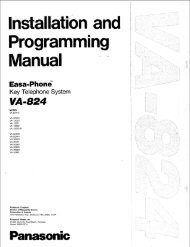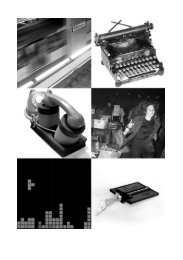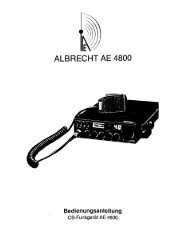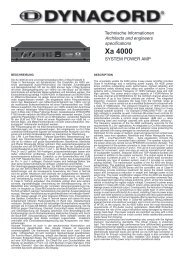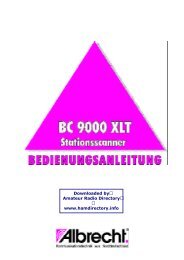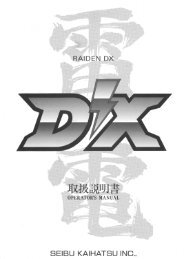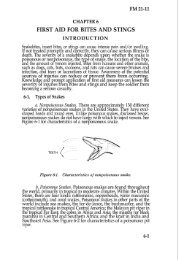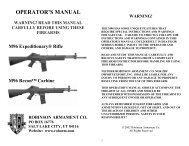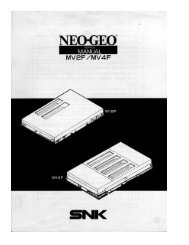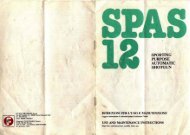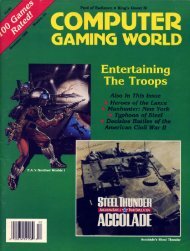The Gamer's Quarter - Issue #6 - TextFiles.com
The Gamer's Quarter - Issue #6 - TextFiles.com
The Gamer's Quarter - Issue #6 - TextFiles.com
You also want an ePaper? Increase the reach of your titles
YUMPU automatically turns print PDFs into web optimized ePapers that Google loves.
the obvious hardware issues prior to<br />
launch and gotten a decent installed<br />
user base. It’s not always a good idea to<br />
listen to gamer opinion when releasing<br />
a game or game console, but in this<br />
case Nokia could have benefited from<br />
responding to their critics. Side talkin’<br />
and removing the battery to change<br />
games were <strong>com</strong>plained about as early<br />
as March 2003, when developers and US<br />
Press first got their hands on the system<br />
at the Game Developers’ Conference. If<br />
Nokia had listened to the criticisms that<br />
arose here they would have saved a lot<br />
of money and ridicule, but instead they<br />
chose to wait until it was obvious that<br />
these things were affecting sales to do<br />
something about them.<br />
On July 26, 2004, less than a year after<br />
the original N-Gage’s introduction, Nokia<br />
released a revised version of the N-Gage<br />
that fixed nearly every aspect of their<br />
ill-fated system: the N-Gage QD. With<br />
this release, the design was modified so<br />
that the player was no longer forced to<br />
remove the battery in order to change<br />
game discs, and, much to the chagrin of<br />
side talkers everywhere, the phone could<br />
now be held like a normal phone. <strong>The</strong>y<br />
also reduced the size, making the outer<br />
edge and buttons rubberized and more<br />
durable in the process. This updated<br />
design wasn’t all pluses though, Nokia<br />
also removed some of the less used<br />
and more costly features, such as the<br />
FM radio, the MP3 player/recorder, and<br />
stereo output from the device’s speakers.<br />
Strangely, despite removing the radio<br />
and music player buttons, an “accept”<br />
button was added, reducing the number<br />
buttons on the QD to a total of twenty<br />
instead of the original’s twenty-one.<br />
With this cheaper-to-manufacture<br />
device the cost of the system was also<br />
reduced. Offering rebates for new cellphone<br />
contracts was explicitly forbidden<br />
by Nokia prior to the release of the QD—<br />
perhaps as a way to make the device<br />
more appealing for standard game stores<br />
to stock—but with the release of the QD,<br />
Nokia actively pushed service-contract<br />
rebates, which would bring the device’s<br />
cost down to $99 from the standard $199<br />
if taken advantage of.<br />
<strong>The</strong> QD also brought with it the N-<br />
Gage’s most unique feature, the N-Gage<br />
Arena. <strong>The</strong> Arena was Nokia’s network for<br />
playing N-Gage games online. In order to<br />
start up the service they actually bought<br />
Sega.<strong>com</strong>, a force that had been instrumental<br />
in bringing the Dreamcast online<br />
just a few years prior. Nokia very clearly<br />
took the Arena seriously, and ended up<br />
creating a service very similar to Xbox<br />
Live; with friends lists, online rankings<br />
and tournaments, game demos, chat, and<br />
message boards all accessible directly<br />
from the phone twenty-four hours a day.<br />
This was Nokia’s greatest achievement<br />
yet, but few games took advantage of it<br />
right away.<br />
With its lower price and vast hardware<br />
improvements Nokia’s system sales<br />
improved. In September of 2004, they<br />
sold their millionth device; far from the<br />
six million they estimated, but much<br />
better than the five thousand systems<br />
sold at launch. Improved hardware alone<br />
would not be enough to turn around the<br />
system’s successes. <strong>The</strong>y would need<br />
better games. <strong>The</strong> platform continued to<br />
receive nothing but ports of games from<br />
other systems right up until the release of<br />
the QD. Thankfully, around the time the<br />
QD hit shelves, Nokia began to release<br />
internally designed games that seemed<br />
tailor-made for the system. It is unknown<br />
whether the influx of new titles was by<br />
design or by lack of developer support,<br />
but during the N-Gage’s second year,<br />
Nokia finally began creating games that<br />
couldn’t be found or wouldn’t be possible<br />
on other handheld platforms, and some<br />
of them were surprisingly good.<br />
Shortly after their millionth system<br />
sold, the N-Gage had its biggest influx of<br />
games yet. In November of 2004, eight<br />
new N-Gage games were released: Call of<br />
Duty; Requiem of Hell; Pocket Kingdom:<br />
Own the World; <strong>The</strong> Elder Scrolls Travels:<br />
Shadowkey; Asphalt: Urban GT; Fifa<br />
Soccer 2005; Colin McRae Rally 2005;<br />
and Pathway to Glory. This marked the<br />
first time that Nokia showed a clear focus<br />
on original games, and some of these<br />
games, Pathway to Glory in particular,<br />
were actually very good.<br />
Finally realizing that “if you build it<br />
they will <strong>com</strong>e” only works for baseball<br />
stadiums, Nokia began to show off their<br />
renewed focus on quality to people<br />
who could get the word out, sending<br />
advance copies of the new device and its<br />
up<strong>com</strong>ing games to a broader range of<br />
major magazines and websites. Sites like<br />
Penny Arcade, who seemed to have done<br />
nothing but mock the system relentlessly<br />
from the beginning, were given a chance<br />
to see how the N-Gage’s faults had been<br />
rectified. Penny Arcade’s Jerry Holkins<br />
summed up the marked change in <strong>com</strong>petency<br />
in his news post for November 26,<br />
2004: “Are they finally figuring something<br />
out? That they have created a platform<br />
with strengths and weaknesses, and<br />
that development can accentuate one of<br />
those and downplay the other? I’ll be God<br />
damned.”<br />
Nokia had finally weeded out all of<br />
their mistakes and the N-Gage seemed to<br />
be doing everything right. Unfortunately,<br />
November 2004 also marked the US<br />
16 <strong>The</strong> Gamer’s <strong>Quarter</strong> <strong>Issue</strong> <strong>#6</strong><br />
<strong>The</strong> N-Gage is Dead; Long Live the N-Gage<br />
17



